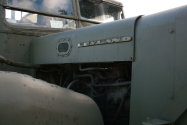Diary reveals soldier’s life as prisoner of war
Monday 29th December 2008
A DIARY of life as a prisoner of war in Germany between 1943 and 1945 has been given to a former Army camp.
Trooper Gilbert Knott’s colourful record of life in enemy hands has been added to other material at Stainton Camp,
near Barnard Castle, showing what happened during and after the Second World War.
After he was released in 1945, he was stationed at Barnard Castle before he was demobbed.
He died in 1979 aged 58, but his son, Peter, has sent a copy of his diary to Eileen O’Hara, who is leading a project
to collect information about the camp.
She said: “We are delighted.
We have information about German prisoners who were kept here, but this is our first record of a British soldier detained
in Germany.”
Mr Knott also sent photographs taken when his father was at Barnard Castle.
They were probably taken at Deerbolt Camp, but troops based there often carried out duties at Stainton.
Gilbert Knott was called up in 1941 and trained at Catterick Camp, in North Yorkshire.
He was captured at Tobruk, in Libya, in June 1942. He was kept there for five months before he was taken to Italy. Ten
months later, after Italy surrendered, he was taken to a prison camp near Dresden and put to work in a coal mine.
Entries in his diary include:
● Oct 28 1943: Reveille 5am.
Went to work at 6am down mine. Came up 2pm.
● Nov 3: Refused to work. German sergeant hit two blokes with his rifle. We worked but under protest. Put on punishment
rations.
● Nov 8: Placed on night shift 3.15pm-midnight. Three fellows escaped but were soon caught.
● Nov 22: Working 20 hours without a break. My birthday – what a day.
● Feb 9: Toothpaste, shaving soap and one toilet roll issued by Red Cross. I lost on draw, but got a few sheets of
toilet paper.
He often wrote about poor meals, a shortage of food, freezing conditions, swapping cigarettes for chocolate or other items
and seeing shows put on by other prisoners.
Mrs O’Hara said: “All these small details give an excellent picture of what life was like for prisoners of
war. They are a valuable addition to the recollections and documents we have gathered.”
Phil Knott, who lives in Newcastle-under-Lyme, Staffordshire, said he was glad his father’s diary and photographs
were useful to the history project.

